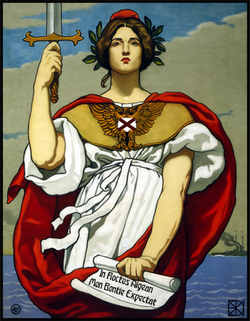Gassavelian people
This article is a work-in-progress because it is incomplete and pending further input from an author. Note: The contents of this article are not considered canonical and may be inaccurate. Please comment on this article's talk page to share your input, comments and questions. |
This article or section is out of date because it is either legacy lore from a participant who is no longer here or because it has been rendered obsolete by new lore. Note: To contribute to this article, you may need to seek help from the author(s) of this page. |
| Regions with significant populations | |
|---|---|
| 84,102,405 | |
| 6,632,537 | |
| 17,104 | |
| Languages | |
| Julian Ænglish, Burgoignesc, Gassavelian (minority) | |
| Religion | |
| Levantine Catholicism, Protestantism (historical), Nestorianism (historical) | |
The Gassavelian people are an ethic group native to Levantia. Descendants of Uzdehzani refugees fleeing the Oduniyyad Caliphate in the 7th century, the Uzdehzani ruled over an eventually married into the native Latinic, Gaelic, and Istroyan, with the resulting Gassavelian culture being firmly established by the 12th century. The new Gassavelian culture retained much of the legacy of the Uzdehzani but adopted elements from all of the local cultures they incorporated, forming a new culture and ethnicity in the process.
Uzdehzani were historically Nestorian until the creation of the Kingdom of Gassavelia, after which time they adopted the Holy Levantine Empire's Catholic faith. Nevertheless, Gassavelians retained many novel and unique religious practices and doctrines, which partially influenced their embracing of Protestantism in the 16th century. The Gassavelians lost national independence to Urcea and Faramount at the end of the Great Confessional War, after which time they returned to the Catholic faith. Despite the division of their Kingdom, Gassavelians retained a high degree of autonomy in Urcea and were eventually given the autonomous state of Gassavelia just prior to the Red Interregnum. In Urcea, not unlike Caenish people, many Gassavelians view themselves as being a special extension of the Urcean ethnicity rather than a separate people due to their related Latino-Gael heritage.
Culture
Religion
Originating as descendants of Uzdehzani refugees in the late 7th century, the Gassavelians initially adhered to Nestorianism, a theological tradition of their Battganuuri heritage. This initial religious orientation persisted until a pivotal juncture marked by the establishment of the Kingdom of Gassavelia. The ascension of Gassavelia into the Holy Levantine Empire heralded a significant transformation in the religious practices of its people. Aligning with the prevailing Catholic faith of the Empire, the Gassavelians underwent a comprehensive shift in their religious allegiance. The theological embrace of Catholicism, facilitated by the coronation of Seoirge Ashrafioun as the first King of Gassavelia, marked a consolidation of religious unity within the Empire's cultural orbit.
Nevertheless, the intrinsic resilience of Gassavelian religious identity manifested notably in the 16th century. During this period of religious tumult in Levantia, the Gassavelians, influenced by distinctive religious practices and doctrinal nuances, underwent a noteworthy conversion to Protestantism. This transition, while deviating from the prevailing Catholicism within the Holy Levantine Empire, underscored the otherness of the Gassavelians but they were not the only ones to turn to the Protestant faith. Their powerful neighbor Urcea's political class had also adopted the new faith and together they formed a strong cohort the eventually became the Protestant Union in the Great Confessional War. During the war the Kingdom of Gassavelia was soundly defeated and partitioned. The ensuing geopolitical rearrangement did not merely shape the territorial landscape but also influenced the religious trajectory of the Gassavelians. The western half, integrated into the now Catholic bastion of Urcea, experienced a return to the Catholic faith but with many of their Gassavelian traditions still in tact. In the East the newly formed Principality of Faramount practiced a more rigid form of Catholicism to legitimize itself as a new state. While Gassavelian idiosyncracies persisted, not to the same extent nor as openly as they were in Urcean Gassavelia.
In the Early Modern Era, Gassavelian religious practices persisted, especially in Urcea, retaining a distinctive character with feast days occurring slightly "off schedule" with other Catholic holidays and the veneration of Saints that were not common in standard practice. The nuanced self-perception of the Gassavelians, viewing themselves as a unique extension of the Urcean ethnicity, further shaped their religious identity within the broader cultural context. The establishment of the autonomous state of Gassavelia just prior to the Red Interregnum marked a reassertion of cultural autonomy, underscoring the enduring interplay between religious beliefs and the socio-political landscape in the intricate narrative of Gassavelian history.
In Faramount and later Burgundie the Gassavelian expression of Catholicism was under much stricter review as the Princes of Faramount sought to establish their control and legitimacy. Since they relied on the defeat of the Protestants in the Great Confessional War as their raison d'etre they saw strict adherence to Catholicism as a central pillar to their reigns. Unlike many of the Maritime Derics, the Principality of Faramount turned inward in the aftermath of the Great Confessional War and focused on the centralization of politics, religion, and culture, to define their Faramountesc identity. Trying to maintain their cultural uniqueness and not fall into the Urcean sphere like those in the western portions of the Kingdom of Gassavelia they formed common cause with many of the other newly formed Catholic states, like the Duchy of Martilles and the Duchy of Bourgondi. These "new kids on the block" often felt belittled or dismissed by the states that pre-dated the Great Confessional War and, as such, formed closer bonds with each other.
| This article is part of a series on the |
| Culture in Burgundie |
|---|
 |
| Society |
| Arts and literature |
| Other |
|
Burgundie portal |
Architecture
- Gassavelian renaissance architecture 1450s-1575
- Faramountesc rococo 1730s-1760s
- Faramountesc School of Art Nouveau 1890s-1910s